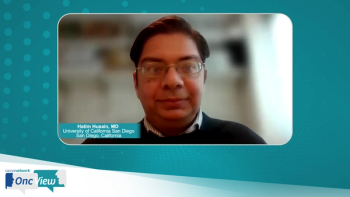
Advances in Later-Line Management of Relapsed/Refractory Follicular Lymphoma
This article reviews advances in later-line management of relapsed/refractory follicular lymphoma. This article also features insights from oncology expert Sameh Gaballa, MD, of Moffitt Cancer Center in Tampa, Florida.
Follicular lymphoma (FL) is an indolent B-cell lymphoproliferative disease that accounts for approximately 20% of all cases of non-Hodgkin lymphoma.1 CancerNetwork® met with Sameh Gaballa, MD, of Moffitt Cancer Center in Tampa, Florida, to discuss the management of relapsed/refractory (R/R) FL. Gaballa said that patients with FL are not expected to be cured after frontline therapy. Most patients relapse, although he noted that approximately 80% of patients remain in remission for 2 or more years after chemoimmunotherapy and have a very good prognosis. Patients who experience progression of disease within 2 years after frontline (POD24) have a worse prognosis.
Treatment of Relapsed/Refractory Follicular Lymphoma
The treatment goal with R/R FL is to control symptoms, said Gaballa. “You’re not going to cure [patients with R/R FL],” he said. “If they have bulky disease, if they have symptomatic disease, then those are the patients who you would consider treatment for. Otherwise, you could just observe them.”
Regarding first-line treatment of R/R FL, Gaballa favors chemoimmunotherapy, such as rituximab and bendamustine, for most patients. He typically reserves R-CHOP (a chemotherapy regimen including rituximab, cyclophosphamide, doxorubicin, vincristine, and prednisone) for patients that he thinks may have transformed disease, and he may offer monotherapy rituximab monotherapy to those who have low bulky disease.
Selection of second-line therapy and beyond may not be so straightforward. “Beyond first line, there is not a 1-standard-of-care regimen,” Gaballa said, noting that the rituximab plus lenalidomide combination is now commonly used in the second line. For third line, there are now several options, including PI3K inhibitors (eg, idelalisib, copanlisib, duvelisib, umbralisib), an EZH2 inhibitor (tazemetostat), and chimeric antigen receptor T-cell therapy, which was just recently FDA approved for third line.
Treatment selection
Gaballa selects treatment for R/R FL on the basis of several patient-related and disease-specific factors, such as patient age, comorbidities, and POD24 status. To choose among the many third-line options, Gaballa discusses all the options with the patients, covering adverse events, route of administration, and monitoring requirements. For example, he noted that copanlisib is administered intravenously, whereas the other PI3K inhibitors that are FDA approved for R/R FL in the third line are oral. Umbralisib has a better safety profile than that of earlier PI3K inhibitors, and the EZH2 inhibitor tazemetostat is very well tolerated and does not require a lot of monitoring.
At this time, molecular testing is not necessary to determine optimal treatment—even for use of tazemetostat. “If [tazemetostat is used for a] later line of therapy and you think there [are] no good alternatives, you don’t have to do the testing,” Gaballa said, alluding to the approval of tazemetostat to treat patients with and without an EZH2 mutation. He noted that molecular testing to identify the EZH2 mutation could add value if a clinician wanted to use tazemetostat as an earlier line of treatment.2
Conclusions
Looking ahead, Gaballa stated that the biggest unmet need for FL beyond the second-line setting involves POD24 patients, who have a lower survival rate than other R/R FL patients. “It [will] be great if we have better tools to risk stratify these patients and identify [them] early on,” he said. He also noted the potential benefit of moving some of the approved third-line therapies (eg, tazemetostat) and regimens to earlier lines of therapy or combining them with other agents.
REFERENCES
1. Monga N, Nastoupil L, Garside J, et al. Burden of illness of follicular lymphoma and marginal zone lymphoma. Ann Hematol. 2019;98(1):175-183. doi:10.1007/s00277-018-3501-8
2. Tazverik. Prescribing information. Epizyme Inc; 2020. Accessed May 3, 2021. https://www.tazverik.com/Content/pdf/prescribing-information.pdf
Newsletter
Stay up to date on recent advances in the multidisciplinary approach to cancer.














































































